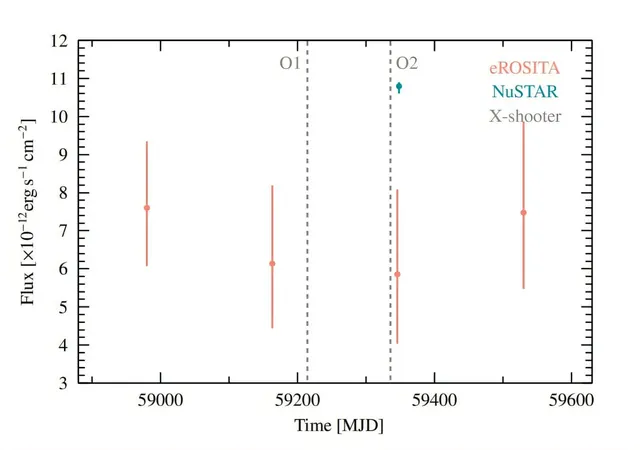
Unveiling the Mysteries of an X-ray Binary with a Red Supergiant: A Galactic Discovery!
2024-11-14
Author: Nur
Introduction
An international team of astronomers has made significant strides in understanding an intriguing X-ray binary, designated 1eRASS J085039.9-421151, through a comprehensive multiwavelength study. The findings, published on November 4 on the preprint server arXiv, shed light on the system's nature and properties, tantalizing researchers and space enthusiasts alike.
What are X-ray Binaries?
X-ray binaries (XRBs) are fascinating celestial entities formed when a normal star or a white dwarf transfers mass to a compact object such as a neutron star or a black hole. These binaries are classified into low-mass X-ray binaries (LMXBs) and high-mass X-ray binaries (HMXBs) based on the mass of the companion star. This particular binary, known informally as J085039, was first detected as an X-ray source during the inaugural eROSITA All-Sky Survey (eRASS1).
Proximity to a K-type Supergiant Star
Interestingly, J085039 is positioned very close to a K-type supergiant star, UCAC2 13726137, located just three arcseconds away. This proximity led astronomers to suspect that J085039 was an X-ray binary. Further investigations estimate that this system lies approximately 24,300 light-years from Earth, adding to its allure.
Research Analysis
Under the leadership of Aafia Zainab from the University of Erlangen–Nuremberg in Germany, researchers have embarked on a detailed analysis of J085039. They utilized data from advanced telescopes, including the extended ROentgen Survey Imaging Telescope Array (eROSITA) onboard the Spektr-RG spacecraft, the Nuclear Spectroscopic Telescope Array (NuSTAR), and the X-shooter instrument on the Very Large Telescope (VLT).
Classification of J085039
Their analysis confirmed that J085039 is classified as an HMXB, comprising a neutron star and a red supergiant companion, falling into spectral types M2-3. This fascinating revelation marks J085039 as only the second known galactic X-ray binary with a red supergiant, raising intriguing questions about the formation and evolution of such systems.
Discoveries and Measurements
Diving into the metrics, the researchers discovered J085039 possesses a staggering X-ray luminosity of 300 decillion erg/s, accompanied by a mass accretion rate onto the neutron star of approximately 1.72 trillion kg/s. Over a 13-year observation period, the lightcurve showcased a strikingly low flux, indicating steady emissions.
Fluorescent Iron Line and Variability
Moreover, the team detected a powerful fluorescent neutral iron line within J085039's spectrum, suggesting that the source of X-rays may be obscured by the stellar wind of the supergiant companion or other surrounding materials. While the study did not report any significant outbursts or pulsations, the researchers remain open to the possibility that variability could exist below their detection threshold, particularly those fluctuations occurring over periods longer than 200 seconds.
Conclusion and Future Exploration
This groundbreaking research not only enhances our understanding of X-ray binaries but also opens new avenues for future exploration of similar celestial phenomena. As astronomers continue to investigate the depths of our galaxy, the mysteries surrounding systems like J085039 may soon offer even greater insights into the complex dance of stellar life and death in the cosmos. Stay tuned for more updates on this stellar saga!


 Brasil (PT)
Brasil (PT)
 Canada (EN)
Canada (EN)
 Chile (ES)
Chile (ES)
 España (ES)
España (ES)
 France (FR)
France (FR)
 Hong Kong (EN)
Hong Kong (EN)
 Italia (IT)
Italia (IT)
 日本 (JA)
日本 (JA)
 Magyarország (HU)
Magyarország (HU)
 Norge (NO)
Norge (NO)
 Polska (PL)
Polska (PL)
 Schweiz (DE)
Schweiz (DE)
 Singapore (EN)
Singapore (EN)
 Sverige (SV)
Sverige (SV)
 Suomi (FI)
Suomi (FI)
 Türkiye (TR)
Türkiye (TR)